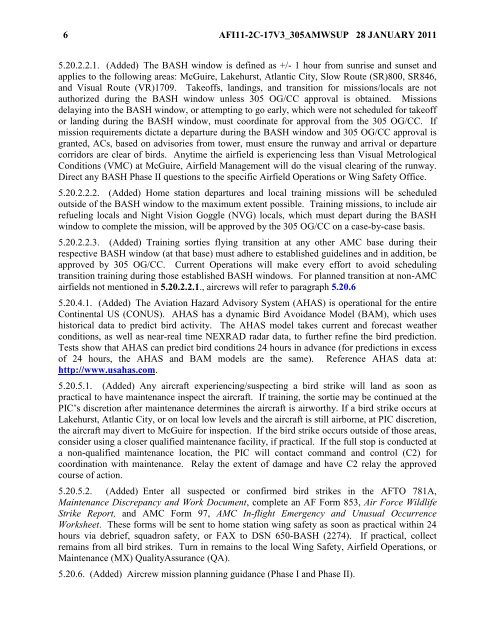BY ORDER OF THE COMMANDER 305TH AIR MOBILITY WING ...
BY ORDER OF THE COMMANDER 305TH AIR MOBILITY WING ...
BY ORDER OF THE COMMANDER 305TH AIR MOBILITY WING ...
Create successful ePaper yourself
Turn your PDF publications into a flip-book with our unique Google optimized e-Paper software.
6 AFI11-2C-17V3_305AMWSUP 28 JANUARY 2011<br />
5.20.2.2.1. (Added) The BASH window is defined as +/- 1 hour from sunrise and sunset and<br />
applies to the following areas: McGuire, Lakehurst, Atlantic City, Slow Route (SR)800, SR846,<br />
and Visual Route (VR)1709. Takeoffs, landings, and transition for missions/locals are not<br />
authorized during the BASH window unless 305 OG/CC approval is obtained. Missions<br />
delaying into the BASH window, or attempting to go early, which were not scheduled for takeoff<br />
or landing during the BASH window, must coordinate for approval from the 305 OG/CC. If<br />
mission requirements dictate a departure during the BASH window and 305 OG/CC approval is<br />
granted, ACs, based on advisories from tower, must ensure the runway and arrival or departure<br />
corridors are clear of birds. Anytime the airfield is experiencing less than Visual Metrological<br />
Conditions (VMC) at McGuire, Airfield Management will do the visual clearing of the runway.<br />
Direct any BASH Phase II questions to the specific Airfield Operations or Wing Safety Office.<br />
5.20.2.2.2. (Added) Home station departures and local training missions will be scheduled<br />
outside of the BASH window to the maximum extent possible. Training missions, to include air<br />
refueling locals and Night Vision Goggle (NVG) locals, which must depart during the BASH<br />
window to complete the mission, will be approved by the 305 OG/CC on a case-by-case basis.<br />
5.20.2.2.3. (Added) Training sorties flying transition at any other AMC base during their<br />
respective BASH window (at that base) must adhere to established guidelines and in addition, be<br />
approved by 305 OG/CC. Current Operations will make every effort to avoid scheduling<br />
transition training during those established BASH windows. For planned transition at non-AMC<br />
airfields not mentioned in 5.20.2.2.1., aircrews will refer to paragraph 5.20.6<br />
5.20.4.1. (Added) The Aviation Hazard Advisory System (AHAS) is operational for the entire<br />
Continental US (CONUS). AHAS has a dynamic Bird Avoidance Model (BAM), which uses<br />
historical data to predict bird activity. The AHAS model takes current and forecast weather<br />
conditions, as well as near-real time NEXRAD radar data, to further refine the bird prediction.<br />
Tests show that AHAS can predict bird conditions 24 hours in advance (for predictions in excess<br />
of 24 hours, the AHAS and BAM models are the same). Reference AHAS data at:<br />
http://www.usahas.com.<br />
5.20.5.1. (Added) Any aircraft experiencing/suspecting a bird strike will land as soon as<br />
practical to have maintenance inspect the aircraft. If training, the sortie may be continued at the<br />
PIC’s discretion after maintenance determines the aircraft is airworthy. If a bird strike occurs at<br />
Lakehurst, Atlantic City, or on local low levels and the aircraft is still airborne, at PIC discretion,<br />
the aircraft may divert to McGuire for inspection. If the bird strike occurs outside of those areas,<br />
consider using a closer qualified maintenance facility, if practical. If the full stop is conducted at<br />
a non-qualified maintenance location, the PIC will contact command and control (C2) for<br />
coordination with maintenance. Relay the extent of damage and have C2 relay the approved<br />
course of action.<br />
5.20.5.2. (Added) Enter all suspected or confirmed bird strikes in the AFTO 781A,<br />
Maintenance Discrepancy and Work Document, complete an AF Form 853, Air Force Wildlife<br />
Strike Report, and AMC Form 97, AMC In-flight Emergency and Unusual Occurrence<br />
Worksheet. These forms will be sent to home station wing safety as soon as practical within 24<br />
hours via debrief, squadron safety, or FAX to DSN 650-BASH (2274). If practical, collect<br />
remains from all bird strikes. Turn in remains to the local Wing Safety, Airfield Operations, or<br />
Maintenance (MX) QualityAssurance (QA).<br />
5.20.6. (Added) Aircrew mission planning guidance (Phase I and Phase II).
















